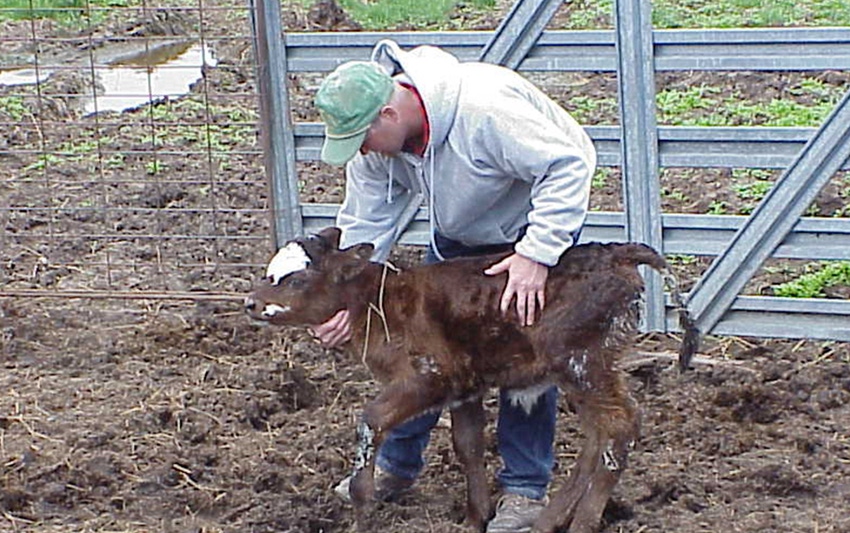Majority of diarrhea cases occur when calves are 3-16 days old.
March 26, 2020

Cattle producers need to be on the lookout for calf diarrhea, according to North Dakota State University (NDSU) Extension livestock experts. The majority of cases of scours, or diarrhea, occur when calves are 3-16 days old. Untreated calves essentially die of shock from a loss of fluids and electrolyte imbalances.
“Calf scours is most often associated with infectious, environmental and nutritional stresses,” NDSU Extension veterinarian Gerald Stokka said.
A number of infections can cause viral and bacterial calf scours. Viral infections associated with calf diarrhea include rotavirus and coronavirus.
Rotavirus causes the calves’ intestinal tract to secrete fluid into the intestinal tract, resulting in severe dehydration and electrolyte imbalances, while coronavirus destroys the cells lining the intestinal tract and causes malabsorption, resulting in severe diarrhea and lack of nutrient absorption.
Neither of these viruses is associated with infections in people, Stokka said, while Escherichia coli and salmonella species are bacterial pathogens associated with calf diarrhea that can be associated with infections in people.
A different infectious organism called cryptosporidium is a protozoan parasite that causes scours. Cryptosporidia usually are found in conjunction with other scours-causing bacteria or viruses and may cause infections in people as well. “Unfortunately, this organism presents management problems, as there is no vaccine or licensed therapeutic agent available,” Stokka said.
Conditions leading to scours
“Inadequate nutrition for the pregnant dam, particularly during the last third of gestation, as well as the calf’s exposure to poor environmental conditions, insufficient attention to the newborn calf or a combination of these often result in scours outbreaks,” said Karl Hoppe, Extension livestock systems specialist based at the NDSU Carrington Research Extension Center.
Not meeting the pregnant dam’s energy and protein requirements will decrease the quality and quantity of the cow’s colostrum. Colostrum is a form of milk that mammals produce in late pregnancy. It contains energy, protein, fat and vitamins, plus antibodies to protect newborns against disease until their own immune system is totally functional. Deficiencies in vitamins A and E and trace minerals have been associated with greater incidence of calf scours.
“Inadequate environment conditions, such as mud, overcrowding, contaminated lots, calving heifers and cows together, wintering and calving in the same area, storms, heavy snow, cold temperatures and rainfall are all stressful to the newborn calf and increase its exposure to infectious agents,” added Janna Block, Extension livestock systems specialist based at the NDSU Hettinger Research Extension Center.
“Attention to the newborn calf is essential, particularly during difficult births or adverse weather conditions,” Stokka said. “The calf is born without most antibodies, including those that fight the infectious agents that cause scours. The calf will acquire these antibodies only from colostrum. Because of this, any effort to prevent scours by vaccinating cows is wasted unless the calf actually receives colostrum, preferably before it is two to six hours old.
“As the calf grows older, it rapidly loses its ability to absorb colostral antibodies,” he added. “Colostrum given to calves that are more than 24-36 hours old will be less than ideal, as antibodies are seldom absorbed this late in life.”
Under range conditions, a calf adapts a pattern of nursing that fills its needs. Calf scours can be the result of anything that disrupts this normal habit, such as a storm, strong winds or the dam going off in search of new grass.
When the calf eventually nurses, it is overly hungry, and the cow has more milk than normal. This inconsistent nursing may lead to enterotoxemia. The organism most often involved with this is Clostridium perfringens, which has several types.
The disease has a sudden onset. Affected calves become listless and strain or kick at their abdomen. Bloody diarrhea may or may not occur. In some cases, calves may die without any signs being observed.
Treating scours
“The key to successful treatment is identifying and successfully treating a dehydrated animal early,” Stokka said.
Calves that have lost significant amounts of fluid will have skin that “tents” (stays up for more than three seconds when pulled away from the body), a dry mouth, cold ears and sunken eyeballs. They often have low blood sugar, low body temperature and low urine output and decreased blood electrolyte (sodium, potassium, bicarbonate, chloride) levels that adversely affect organ function, particularly the heart. They are visibly depressed.
The critical first step in treating cases of calf scours is correcting dehydration and electrolyte loss. Antibiotics can be administered if a veterinarian deems it to be appropriate.
Stokka recommended using a nipple bottle to replace the calf’s fluids if scours is detected early, when the calf still is standing and relatively bright.
“In these situations, it is best to leave the calf on milk and add several two-quart electrolyte feedings a day to replace the fluid that is being lost through diarrhea,” he said.
Calves that are down but alert probably need to have fluids administered with a stomach tube. They will need two quarts of a high-energy electrolyte solution containing glucose several times a day.
Producers may need to provide a heat source as well. Calves that are comatose or lying down must be administered fluids intravenously. Producers need to be thorough when replacing fluids in a scouring animal, according to Stokka.
“First of all, the amount of fluid lost must be replaced,” he said. “It is a common mistake to give the animal too little fluids. A 100 lb. calf that is 10% dehydrated will need about 10 liters of fluid a day just to replace fluid loss.”
You May Also Like


.png?width=300&auto=webp&quality=80&disable=upscale)
